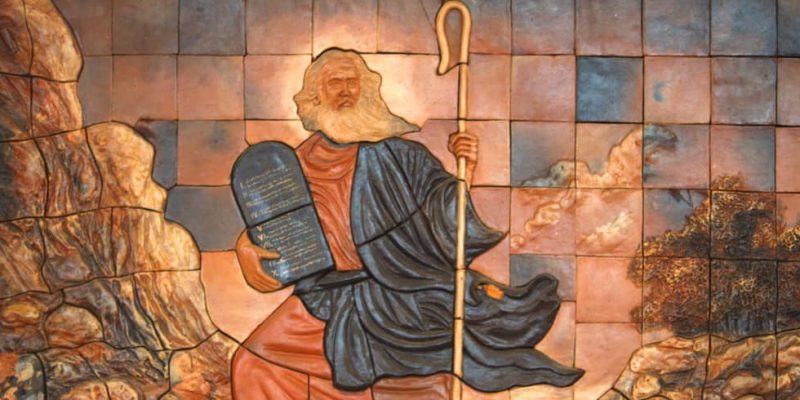We explain what Judaism is, its origin, characteristics and beliefs. Also, what are its main currents and its sacred books.

What is Judaism?
Judaism is the religion of the Jewish or Hebrew people whose origins date back to the religion of the ancient Hebrews of the 2nd millennium BC. C and, more specifically, to the adoption of monotheism in the 6th century BC. C. It is one of the three great Abrahamic religions, along with Christianity and Islam. This means that the three are recognized as heirs of the history of the prophet Abraham (Ibrahim in Arabic), the first of the three great biblical patriarchs, and that They believe in the existence of one and only creator God.
However, the term Judaism also refers to the complex phenomenon of Jewish culture, in which religion, customs, the idea of justice and social organization are integrated, based on tradition and sacred texts. So that Judaism is considered, at the same time, a religion, a culture and an ethnic identity (which recognizes its origins in the ancient Hebrew people of the Near East).
There is no single, homogeneous way to practice Judaism nor a single universal, organized and systematized body of religious texts by which the entire Jewish community is guided. The strictest application of the ritual and legal norms of Judaism is observed in the Haredi or ultra-Orthodox communities, but different Jewish currents have varying degrees of adaptation to historical changes. However, the Torah and the rest of the books that make up the Hebrew Bible or Tanakh (broadly equivalent to the Old Testament of the Christian Bible) constitute the central sacred books of this religion.
Judaism has an extensive and complex cultural history, since it is a religion and a way of life with ancient roots that went through migrations, exiles and persecutions. Currently, there are Jewish meeting and prayer places (called synagogues) of greater or smaller size in many countries, where the Jewish congregation gathers to receive spiritual and moral guidance from a rabbi.
Key points
- Judaism is one of the oldest monotheistic religions in the world, emerging in the 6th century BC. C. from the religion of the ancient Hebrew people.
- It is based on the belief in a single creator God, who established a pact with the patriarch Abraham and gave Moses the tables of the law with the ten commandments.
- The two most numerous religions in the world, Christianity and Islam, are derived from it, and together they are often called Abrahamic religions.
- Its holy book is the Hebrew Bible, also called Tanakh, the most important part of which is the Torah (also known as the Pentateuch), the first five biblical books that are the basis of Jewish religious law.
- The main currents of Judaism are Orthodox, Reform, Conservative, Reconstructionist and Secular.
See also: Religious norms
Characteristics of Judaism

The general characteristics of Judaism are:
- It is an Abrahamic and monotheistic religion that is, it postulates the existence of a single God, omnipresent and creator of the universe, who in the biblical texts is called Yahweh (although today this name is omitted). This God would have manifested himself to all the patriarchs and prophets of the Bible, such as Noah, Abraham, Moses, among others.
- Jewish religion and identity are represented through star of david a symbol that since the Middle Ages has been associated with the decoration of King David's shield according to the interpretation of some liturgical texts, and the menorah (seven-branched ritual candelabrum), installed in Antiquity in the temple of Jerusalem.
- Jewish rites and celebrations are governed by the Hebrew calendar which combines the lunar and solar cycles, and whose origins date back to Antiquity. In this calendar, the days begin at sunset, the weeks begin on Sunday, and the years have twelve months of 29 or 30 days (a month is added in leap years). On Saturdays (sabbath either shabbat) are the seventh day of the week and are sacred days intended for rest, so no work should be carried out, as they commemorate the day on which, according to Genesis, God rested after creating the universe.
- The Jewish people are governed by Jewish law or halacha alternatively called regulation, as it concerns legal and ethical standards. It is contained in the Talmud, the main legal and ritual corpus of the Jewish religion, and is inspired by the Torah and other religious texts.
- The ritual language of Judaism is Hebrew considered a sacred language. The sacred books and most other Jewish religious texts are written in this language. However, there are also communities in which the liturgical language is Yiddish or Ladino.
- Jewish spaces for communal worship are called synagogues and religion is also studied and, sometimes, social activities are held. Rabbis exercise spiritual authority and officiate at ceremonies.
- The main rituals of passage in Judaism are the brit milah (the circumcision of children, eight days after their birth, which seals the alliance between God and the Jewish people), and the bar mitzvah or bat mitzvah (which respectively admit the thirteen-year-old boy and the twelve-year-old girl into the adult Jewish community).
- Non-Jews (called “Gentiles” or goyim) can convert to religion at will and in that case they become considered Jews by the rest of the community. To do this, it is necessary to complete a series of stages that include the study of the Jewish religion, male circumcision, a purification bath in a mikveh (ritual water source) and approval by a rabbinic court.
- Judaism conforms to the kosher diet which follows specific regulations regarding what is considered ritually acceptable. Therefore, it prohibits the consumption of pork and other animals considered “impure,” and requires the preparation of meat using a specific bleeding method. In addition, it prohibits any proximity between blood and milk.
Origin of Judaism
Judaism As a monotheistic religion it emerged in the Near East in Antiquity, around the 6th century BC. c For its part, the term “Jew” derives from the name of the tribe and kingdom of Judah (established in the southern Levant around the 9th century BC), and began to be used to refer to all Hebrews later. of the Babylonian captivity in the 6th century BC. C. However, the Jewish religion It was a development of some earlier beliefs which probably date back to the ancient Hebrews of the 2nd millennium BC. c.
According to their own founding myths, which have a religious function, the history of judaism began with the patriarch Abraham who was summoned by God to leave his homeland in Mesopotamia and go to a region known at the time as Canaan (in the southern Levant), which became the land promised to his descendants. In this way, Abraham sealed the covenant of the Hebrew people with God.
Abraham, his son Isaac and his grandson Jacob began a life of nomadic shepherds with their tribe, until the Hebrews were reduced to slavery in Egypt. Then, a new prophet was chosen by God: Moses, who led his people back to Canaan, in an exodus that lasted 40 years in the desert. On this trip, Moses received the Tables of the Law with the ten commandments which since then form the legal and moral basis of the Jewish people.
Finally, the Hebrews conquered Canaan, and there the united monarchy of Israel was organized, formed by the union of the twelve tribes of Israel under the authority of a single king (first Saul, then David, and finally Solomon).
Currently, there is agreement among historians that This religious story has no historical basis. Although some authors consider that David and Solomon were historical figures, others maintain that in the Bible there is only data from historical reality from the narratives that allude to the dynasty of Omri, which ruled the northern kingdom of Israel in the 16th century. IX (after the supposed united monarchy of David and Solomon).
Main beliefs of Judaism

The main beliefs of Judaism are:
- There is only one God creator of the universe, and his chosen people are the people of Israel, with whom he established a pact since ancient times (according to the biblical text, since the times of the patriarch Abraham). For this reason, according to the Bible, the Jewish people must be “a light among the nations” and carry God's message to the world. However, Judaism does not proselytize.
- The ten commandments collected in the Bible were dictated by God to Moses on Mount Sinai, to regulate the religious and moral behaviors of the Jewish people.
- In the future there will come a Messiah (“anointed”) that is, a descendant of the house of David sent by God to govern the Jewish people and the rest of the world and establish a new era of peace. Unlike Christianity, Judaism does not believe that Jesus of Nazareth was the Messiah (except for a minority group known as Messianic Judaism), and therefore continues to await his arrival.
Currents of Judaism
There are different currents of Judaism, among which Orthodox Judaism, Reform Judaism, Conservative Judaism, Reconstructionist Judaism and Secular Judaism stand out:
- Orthodox Judaism. Of rigorous adherence to Jewish law or halachais one of the majority currents of Judaism. Different trends can be classified in it. The most extreme is ultra-orthodox Judaism, also called Haredi either haredi (Hebrew: “those who tremble” before God), which practices a particularly devout and traditionalist Judaism, maintains a certain distance from modern society and has strict rules of dress that include the use of black clothing. The ultra-Orthodox trend includes the Hasidim and the Misnagdis. At the other extreme is Modern Orthodox Judaism, more connected to secular society and willing to adapt its beliefs to the contemporary world.
- Reform Judaism. Also called progressive or liberal Judaism, it emerged in Germany in the 19th century with the intention of reconciling the values of liberalism and modern life with the Jewish religion. He promoted a renewed perspective on religion based on the freedom of the individual to interpret religious norms. It became especially strong in the United States.
- Conservative Judaism. Also called masortíemerged in Germany and the United States in the 19th century as a reaction against Reform Judaism, which is why it proposes a return to Jewish law (halacha) and tradition (masoret) but without turning our backs on the context of the modern world and democracy. It is usually considered an intermediate position between Orthodox Judaism and Reform Judaism.
- Reconstructionist Judaism. It emerged in the 20th century in the United States. It defends the importance of traditional Jewish law and practices, but does not consider them mandatory commandments, since it denies them the character of divine revelations. His conception of Judaism is that of a religion and a culture that evolve progressively and whose changes must be accompanied by an adaptation to the needs and values of the contemporary world.
- Secular Judaism. It is made up of all those who belong to the Jewish tradition for family or cultural reasons, but who hardly practice religious rites and are not governed by Jewish laws.
Main holidays of Judaism
The main Jewish holidays, which are part of the Hebrew calendar of twelve lunar months, are:
- Passover. Also known as Jewish Passover, it commemorates the departure of the Hebrews from Egypt, according to the biblical story, and consists mainly of a ritual dinner in which, among other foods, unleavened bread is consumed.
- Shavuot. It commemorates the biblical episode in which God gives Moses the Tables of the Law with the ten commandments, and also constitutes a thanksgiving for the first harvests of the year. Includes the consumption of dairy foods.
- Rosh Hashanah. Celebrate the Jewish New Year during the first two days of the month Tishrei of the Hebrew calendar. It is the anniversary of the creation of the universe, and during this date the shofara wind instrument consisting of a ram's horn.
- Yom Kippur. Called the Day of Atonement or the Day of Forgiveness, it consists of twenty-four hours of fasting, reflection, prayer and repentance. It is the culminating and most sacred point of a ten-day period of penance, beginning on Rosh Hashanah, and in which forgiveness is sought for offenses committed.
- Sukkot. Known as the Feast of Booths and the Feast of Tabernacles, it lasts a week and commemorates the forty years of pilgrimage of the Hebrews through the desert after the departure from Egypt, as narrated in the biblical story. It also celebrates the harvesting of the last crops. Believers build huts or tabernacles with branches in gardens or near synagogues, where they eat and sleep, in imitation of the ancient Hebrew people.
- Simchat Torah. Celebrated on the last day of Sukkot, it marks the end of the annual Torah reading cycle and the beginning of a new cycle, with the reading of the first chapter of Genesis. This celebration is associated with joy and joy, and includes a procession with the scrolls of the holy book inside and outside the synagogues.
- Hanukkah. Called the Festival of Lights or the Festival of the Luminaries, it lasts eight days and is celebrated approximately on the same dates as Christmas for Christians. It commemorates the victory of the Jewish leader Judas Maccabeus against Seleucid domination in 164 BC. C., which led to the new consecration of the Jerusalem temple after having been desecrated. Families light one candle each day from a Hanukkah menorah (a nine-branched candelabra, different from the traditional menorah which has seven), and on the eighth they all remain lit (including the candle in the central candelabra, which is the one used). to turn on the others).
- Purim. It celebrates the salvation of the Jewish people from being exterminated by order of a Persian official named Haman, according to the story told in the biblical book of Esther. It is celebrated by sending gifts to relatives and friends, and performing charitable deeds.
- Yom Hashoah and Yom Ha'atsmaut. Celebrated by many Jews, these commemorations have a more recent history, linked to two events of the 20th century: the Shoah or Holocaust (the extermination of six million Jews by the Nazi regime during World War II) and the creation of the State of Israel. (1948).
Books of Judaism
Judaism has a holy book, known as Tanakh or Hebrew Bible which is made up of 24 books that also make up the Old Testament of the Christian Bible. These books are grouped into three parts:
- Torah. It literally means instruction and is also called Pentateuch, as it contains the first five books of the Bible (Genesis, Exodus, Leviticus, Numbers and Deuteronomy), considered a revealed teaching and the basis of Jewish religious law.
- Neviim. It contains the so-called books of the prophets, consisting of four books of historical or previous prophets (Joshua, Judges, Samuel and Kings) and four books of later prophets (Isaiah, Jeremiah, Ezekiel and the twelve minor prophets).
- Ketuvim. In Hebrew it means Writings and contains eleven books of various genres, such as religious poetry and wisdom literature (Psalms, Proverbs, Job, Song of Songs, Ruth, Lamentations, Ecclesiastes and Esther) and so-called historical or prophetic books (Daniel, Ezra-Nehemiah and Chronicles).
Additionally, Judaism has other important books that govern its law and religious life:
- Talmud. In a broad sense, it is made up of two compilations of texts, called Mishnah and Gemara, although sometimes only the second is called Talmud. It has two versions (Jerusalem Talmud and Babylonian Talmud) and is a fundamental book of rabbinic Judaism, but its authority is rejected by some Jewish currents.
- Mishna. It is a written collection of ancient oral laws that complement written Jewish law.
- gemara. It is a set of commentaries and interpretations of the Mishnah.
- Shulchan Aruch. It is a legal code composed in the 16th century to organize Jewish legislation that existed from Antiquity to the Middle Ages.
- Zohar. Known as the Book of Splendor, it is primarily a mystical commentary on the Torah written in the 13th century. It is one of the main books of the Kabbalistic current of Judaism.
References
- De Lange, N. (1994). The Jewish people. Odyssey through the centuries. Folio.
- Filoramo, G., Massenzio, M., Raveri, M., & Scarpi, P. (2000). History of religions. Criticism.
- Finklestein, I., & Silberman, N. A. (2003). The Bible unearthed. A new archaeological vision of ancient Israel and its sacred texts. 21st century.
- Roitman, A. (2013). Bible, exegesis and religion. A critical-historical reading of Judaism. Divine Word.
- Silberman, L.H. et al. (2024). Judaism. Encyclopedia Britannica. https://www.britannica.com/





